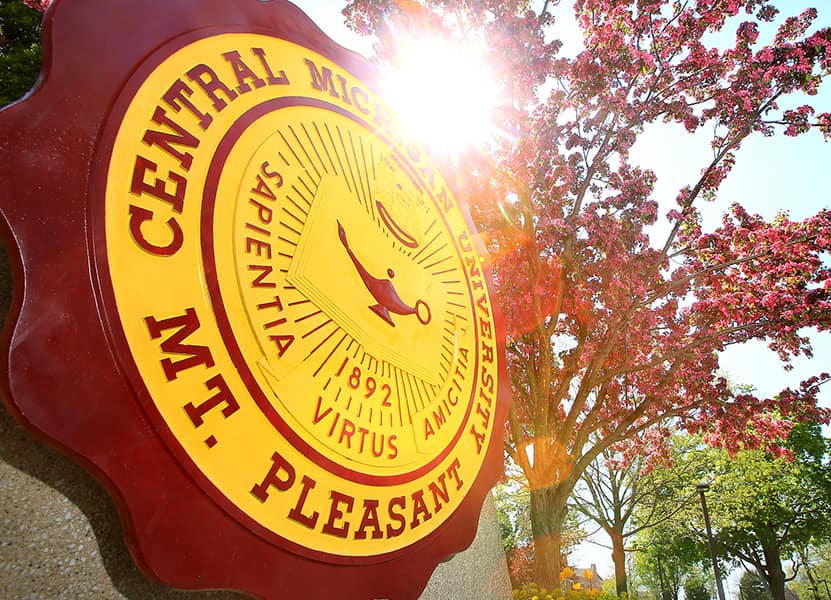In 1926, Lewis D. Capen of Millbrook, Mecosta County, Michigan, became the Exalted Cyclops of the Mecosta Klan No. 28. He served in the leadership position, an equivalent to chapter president, until 1929 when he became Great Kaliff or Grand Titan, a leadership position over Province # 4, which included the Klans of Ionia and Mecosta counties, and the towns of Petoskey, East Jordan, Hart, Manistee, Portland, and Muskegon, Michigan. Besides his Klan activities, Capen, born in Milbrook, Michigan, in 1892, he was a member of the Independent Order of Odd Fellows, Level Lodge 219 of Milbrook. Note: a large collection of these records is also available at the Clarke. Capen was also a veteran of World War I and postmaster of Milbrook. On October 14, 1935 he married Hilda Hill, a teacher.
Capen’s accumulated organizational correspondence, membership cards, publications, forms, and photographic materials constitute the bulk of this collection. The Klans of Mecosta, Osceola, and Shiawassee, as well as those in Province # 4, mostly in lists, and the Women of the Ku Klux Klan mostly in forms and publications, are documented in this collection.
The membership cards for the Mecosta Klan are photocopies. They are organized alphabetically by surname. Each card usually includes the member’s name, age, home county, city or township, and address. A few remarks and financial notes maybe included.
Used in conjunction with other Klan collections and newspapers at the Clarke, this collection provides an insider’s view of life in the Michigan Klan during the 1920s-1930s.
Biography:
There have been three major cycles of Ku Klux Klan activities in the United States. The first cycle began when the Ku Klux Klan was formed in December of 1865 by six young ex-Confederate officers in Pulaski, Tennessee. They derived the name of their organization from “kulosv,” the Greek word for circle. Originally formed for the amusement of bored youth, the organization quickly adopted tactics of violence and terror directed at controlling African Americans in the South during the Reconstruction. It was the extensive use of force and inability of a national organization to establish control of local groups that proved to be the undoing of the Klan. The national organization dissolved in 1869, but activities of local groups were not effectively terminated until 1872.
The Klan was reborn in 1915 in Atlanta, Georgia, under the leadership of William J. Simmons. The organization grew slowly until 1920 when it contracted the services of the Southern Publicity Association, headed by Edward Young Clarke and Mrs. Elizabeth Tyler, to handle recruitment and publicity. In this incarnation, the Klan was not specifically focused against African-Americans, instead it promoted itself as the defender of “American values.” Recruiters were to find out the concerns of a community and represent the Klan as the solution to those issues. The list of Klan concerns grew to include: Catholics, Jews, Asian Americans, African Americans, drugs, adultery, sex, bootlegging, violations of the Sabbath, and many others.
Under the tutelage of Clarke and Tyler the Klan became quite a financially successful institution, which encouraged good salesmanship. Each member had to pay a ten dollar initiation fee called a Klectoken, which was divided up as follows: $4 to the recruiter, or Kleagle; $1 to the state sales manager, or King Kleagle; $ .50 to the regional sales manager, or Grand Goblin; $2.50 to Clarke and Tyler; $2 to Simmons.
By the mid-1920s, the national Klan had well over three million members and political clout from Maine to California. In Michigan, the Klan grew to approximately 75,000-80,000 members, about half of which were in the Detroit area. Before Michigan was officially incorporated into the national system, the Klan recruited under the fictitious name of “National Research Bureau.” While waiting for incorporation, the Detroit Klansmen created their own independent organization, the “Spend Your Money With Americans” club. The Michigan Klan was constantly plagued by bickering over how to distribute its financials spoils. This fact, combined with the lack of significant political success and the use of excessive violence, helped push the Michigan Klan into decline by 1926.
The same three factors; violence, politics, and financial exploitation by the leadership; led to a decline in the national Klan, which by 1928 had decreased to several hundred thousand members. Although not officially dissolved until 1944 to pay off back taxes, the Klan had lost most of its influence.
The Klan was formed for a third time in October 1946 and continues to exist. The current version has never gained the influence of its predecessors, although activity and violence grew substantially in response to the Civil Rights movement of the mid-1950s and 1960s. During this period, the group’s wrath refocused on African Americans.
This collection dates from the second incarnation of the Klan, when its power was at its zenith. The membership records of the Newaygo County branch of the Ku Klux Klan were kept on the farm of Mr. Anderson, the group’s treasurer, and document both the Klansmen and the woman’s auxiliary unit.
